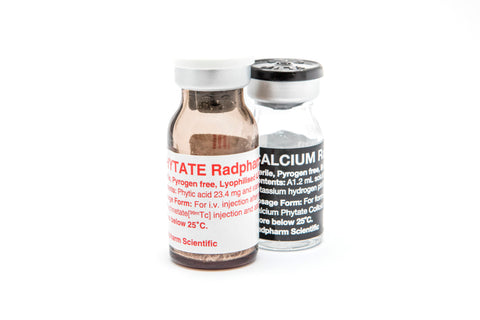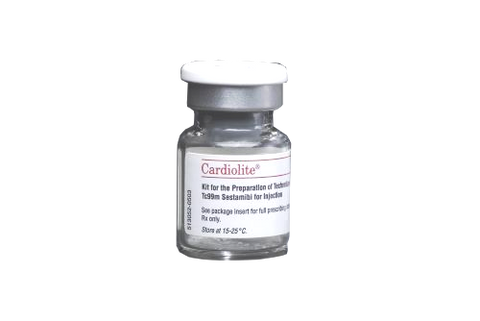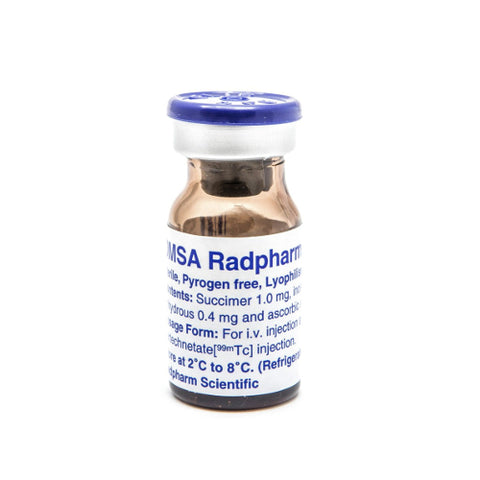- Home
- Catalogue
- Services
- Radiopharmacy
- Contact Us
- Sign in
HDP Radpharm
HDP 2015/1
Radpharm HDP is supplied as sterile, pyrogen free, lyophilised powder, under nitrogen in borosilicate Type 1 glass 10mL vial for intravenous injection following reconstitution with non-pyrogenic 99mTc as pertechnetate sodium (99mTcO4-).
PRODUCT INFORMATION
Radpharm HDP is supplied as sterile, pyrogen free, lyophilised powder, under nitrogen in borosilicate Type 1 glass 10mL vial for intravenous injection following reconstitution with non-pyrogenic 99mTc as pertechnetate sodium (99mTcO4-)
The reconstituted product is a clear, colourless liquid.
Each 10mL tinted vial contains: Sodium oxidronate 3.15mg as an active ingredient; Stannous chloride dihydrate 0.297mg, Gentisic acid 0.84mg and Sodium chloride 29mg as excipients.
Radpharm HDP contains no antimicrobial preservatives.
Technetium [99mTc] Sodium Oxidronate may be used as a skeletal imaging agent to delineate areas of altered osteogenesis in adult patients.
This class of compounds is known to complex cations such as calcium. Particular caution should be used with patients who have, or who may be predisposed to hypocalcemia (alkalosis).
The content of the kit are not radioactive. However, after sodium pertechnetate [99mTc] is added, adequate shielding of the final preparation must be maintained to minimize radiation exposure to occupational workers and patients.
Adequate hydration of the patient is recommended before and after examination to promote urinary flow. Also, urination is recommended as often as possible for 4 to 6 hours after the examination to reduce bladder exposure radiation.
For each patient, exposure to ionising radiation must be justifiable on the basis of likely benefit. The activity administered must be such that the resulting dose is as low as reasonably achievable bearing in mind the need to obtain the intended diagnostic or therapeutic result.
For most diagnostic investigations using a nuclear medicine procedure the radiation dose delivered (EDE) is less than 20mSv. Higher doses may be justified in some clinical circumstances.
Radiopharmaceuticals should only be used by physicians who are qualified by specific training in the safe use and handling of radionuclides.
Contents of the vial are intended only for use in the preparation of Technetium [99mTc] Sodium Oxidronate.
The radioactivity of the dose should be checked with a suitable instrument immediately prior to administration.
Disposal of all radioactive wastes should be carried out in accordance with the NHMRC “Code of Practice for the Disposal of Radioactive Wastes by the User” (1985).
USE IN PATIENTS WITH IMPAIRED RENAL FUNCTION
Patients with renal impairment or suffering from renal obstructions may give rise to a higher level of radiation exposure.
USE IN PATIENTS WITH IMPAIRED GASTROINTESTINAL TRACT
Patients with gastrointestinal tract obstructions may give rise to a higher level of radiation exposure.
WOMEN OF CHILD BEARING AGE
Examinations using radiopharmaceuticals, especially those elective in nature, of women of childbearing capability, should be performed during the first 10 days following the onset of menses.
USE IN PREGNANCY
Women of reproductive age presenting for a Technetium [99mTc] Sodium Oxidronate study must be carefully interviewed to assess the likelihood of pregnancy. Irradiation of a foetus should be avoided whenever possible.
Technetium [99mTc] Sodium Oxidronate should only be given to a pregnant woman if in the judgement of the treating physician the expected benefits outweigh the potential hazards. In cases where medical radiation exposure is justified and considered necessary, the practice should be optimized in order to both minimize the dose to the foetus and achieve a diagnostic study2. It is suggested that in order to achieve this, the use of smaller administered activities and longer imaging times, together with maternal hydration and frequent voiding will lead to a reduced dose to the foetus and a clinically diagnostic study.If clinically justifiable a slight postponement of the examination to a later stage of the pregnancy will also lead to a reduced dose to the foetus2. It should be noted that contamination from radionuclide and radiopharmaceutical impurities can considerably affect the amount of activity transferred to the foetus.Therefore,in order to avoid unjustified doses to the foetus, attention should be paid to quality control of radiopharmaceutical compounds administered.
USE DURING LACTATION
Technetium [99mTc] Sodium Oxidronate is excreted in human milk. If the patient is breast-feeding following administration of Technetium [99mTc] Sodium Oxidronate a procedure should be in place to ensure that the infant will receive a total effective dose of no more than 1mSv3. In order to achieve this it is recommended that the patient express and store milk prior to administration of Technetium [99mTc] Sodium Oxidronate. Following administration of Technetium [99mTc] Sodium Oxidronate a 1 hour interruption to breast feeding and reduced contact with the infant is recommended. During this period of interruption it is recommended that the mother express and discard at least one fraction of milk. Where sample counting facilities are available it may be preferable to directly measure the concentration of the radionuclide in the breast milk to determine the time at which breastfeeding can resume.
To ensure the infant receives a total effective dose of no more than 1mSv breast feeding may resume when the milk activity concentration falls on or below 1kBq/mL3. It should be noted that contamination from radionuclide and radiopharmaceutical impurities can considerably affect the amount of activity in the milk. Therefore, attention should be paid to quality control of radiopharmaceutical compounds administered, in order to avoid unjustified doses to the infant.
CARCINOGENESIS
Carcinogenesis, Mutagenesis and Impairment of Fertility
No long term animal studies have been performed to evaluate carcinogenic or mutagenic potential effects on the foetus.
Adverse reactions to Technetium [99mTc] Sodium Oxidronate are rare. However some hypersensitivity reactions, dermatological manifestations (erythema) and diaphoresis, as well as nausea, vomiting and heartburn have been infrequently associated with Technetium [99mTc] Oxidronate administration.
Hypersensitivity and allergic reactions can often be treated with a non-selective histamine H1 antagonist.
Body as a Whole: hypersensitivity reactions.
Digestive: nausea, vomiting, heartburn.
Skin and Appendages: dermatological manifestations (erythema), injection site
inflammation/reaction.
Related Items
Calcium Phytate Colloid Radpharm
DESCRIPTION Kit for the Preparation of Technetium[99mTc] Calcium Phytate ColloidInjection for Liver/Spleen Imaging. The agent comprises sterile, pyrogen free lyophilised ingredients whichneed reconstitution with sodium... View full product details
Cardolite Sestamibi
Cardiolite® is a technetium-labeled single photon emission computed tomography (SPECT) myocardial perfusion imaging (MPI) agent used for identifying and managing patients with known or suspected... View full product details
Definity
DESCRIPTION Cardiolite® is a technetium-labeled single photon emission computed tomography (SPECT) myocardial perfusion imaging (MPI) agent used for identifying and managing patients with known or... View full product details
DMSA Radpharm
Radpharm DMSA consists of sterile, pyrogen free lyophilised ingredients which need reconstitution with sodium pertechnetate[99mTc] injection to produce a technetium[99mTc] succimer complex suitable for renal imaging.The... View full product details
Sign up to get the latest on sales, new releases and more …
© 2025 GMS Australia Pty Ltd.
PRODUCTS NOT AVAILABLE FOR PURCHASE BY THE GENERAL PUBLIC .ALWAYS READ THE LABEL AND FOLLOW THE DIRECTIONS FOR USE
Powered by Shopify




























